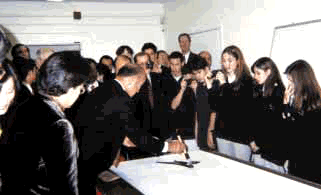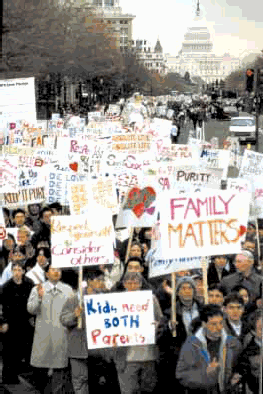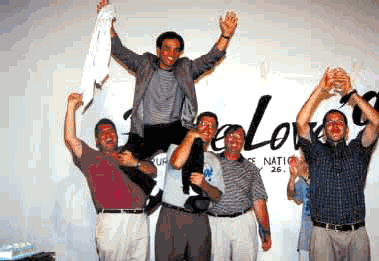
40 Years in America

|
|
40 Years in America |
|
Educating the Second Generation

Rev. Moon painting calligraphy at New Eden Academy, Bridgeport University
Transmitting its identity to the next generation was an exceedingly live issue for most Unificationists at the end of the century. It also was an area in which the American movement seemed poised to make distinctive contributions. By the late 1990s, the movement had proliferated a broad range of educational and religious identity transmitting options. Some of these were aimed at the wider culture with the assumption that if the moral climate of society were raised, all would benefit, including the movementís second generation. Another cluster of initiatives offered value, character and faith-based service programs which, while not exclusively targeting movement youth, nevertheless more closely reflected movement assumptions and the Unification ethos. A final group of institutions, organizations, programs and activities were dedicated to the religious education of the movementís second and, in some cases, its first generation.
The American movementís big ticket items, The Washington Times and the University of Bridgeport, were enterprises aimed at raising the moral literacy of the general public. Although their links to the Unification Movement were well publicized, both were avowedly nonsectarian, and the overwhelming majority of paid employees at each were non-members. Throughout the 1990s, well under ten percent of the student population at the University of Bridgeport were members and there was little sense that it was becoming or ever would become the Brigham Young or Notre Dame University of the Unification Movement. These realities raised questions in more than a few members minds as to why the movement was spending tens and even hundreds of millions of dollars for their support. The answer was not simple. However, it was a fixed principle of Rev. Moon to spend the major portion of movement revenues on projects for social betterment. Skeptics and critics, of course, some of them within the movement, suspected ulterior, perhaps self-aggrandizing motives or that this support was the price exacted for public legitimization. In any case, both of these American-based and run flagship enterprises served as models for similar efforts throughout the world. This was especially true of The Washington Times which spawned sister newspapers in Korea, South America and Europe, many of which were subsidiaries. It was less true for the University of Bridgeport, although Sun Moon University ran along similar lines in Korea.
Apart from the Times and UB there also were grassroots, member-initiated and self-supporting organizations created to educate the public, primarily in the areas of character and abstinence-based sex education. The most impressive of these was the International Education Foundation (IEF), an outgrowth of the movementís CIS mission which produced religious education and character education curriculums and texts on a mass scale in the former Soviet Union. IEF texts such as My World & I and Love, Life and Family (1999) helped fill the ideological void created by the collapse of Marxism-Leninism. Teams of Americans and Europeans, most of them Unification Theological Seminary graduates, with the help of Russian members and educational consultants, wrote and edited the curriculum materials. The enterprise was entirely self-supporting, funded by book proceeds and fundraising. IEF assembled an impressive Board which included some of Americaís leading educators and by the end of the decade had conducted hundreds of conferences in mainland China intended to promote character-based sex education.
In the U.S., the most effective organization of this type, Free Teens, was begun by another UTS graduate, Richard Panzer. In an important article, "Going beyond the Cultural Wars, Re: Love and Sex," Panzer referred to a profound change in his thinking. As he explained it,
I began to ask myself, "What can be known and understood by everyone?" Instead of asking people to make the effort to understand and accept what I believed, I asked myself, "Where are people at now? How can I relate to where they are in a meaningful way, reach their hearts, awaken their consciences?" Sometimes we become rigid and think people should accept everything we believe, but I think half a loaf is better than no loaf. To promote dialogue is the point.
Out of this sea change in his consciousness, Panzer created the Center for Educational Media, produced "Surviving the Sexual Revolution," an effective AIDs prevention program, and authored a variety of publications including Condom Nation: Blind Faith, Bad Science (1997) and Relationship Intelligence (1999). Free Teen chapters were established in a number of U.S. cities, and the organization was able to gain government funding in several of them.

PLA marches in Washington, D.C.
As noted, another cluster of initiatives offered value, character and faith-based service programs which, while not exclusively targeting movement youth, nevertheless more closely reflected movement assumptions and the Unification ethos. New Hope Academy in metropolitan Washington, D.C. was a good example of a model established along these lines that worked and inspired similar efforts by others. Founded in 1990 by local members dissatisfied with daycare and public school options, NHA grew to 100 elementary students (grades 1-8) and 60 daycare children by 1995. Having made a conscious decision not to teach religion, regarding that as the job of parents and churches, forty percent of the children were non-Unificationists, coming from twenty different religions and churches and thirty nationalities. According to the principal, Joy Morrow, "regardless of race, nationality or religion, conscientious parents wanted the same things for their children: an excellent academic program and an atmosphere which supports a child in their development into a moral, deep-hearted, good person." Still, the schoolís commitment to underlying Unification principles was apparent in the decision of its founders to establish a National Association of Shimjung Schools, "shimjung" being a term immediately recognizable to Unificationists as the Korean word for heart.
In addition to formal academic programs, the movement promoted service-learning projects. The most important of these was the Religious Youth Service (RYS). RYS was an outgrowth of the movementís 1980s interfaith work, particularly the Youth Seminar on the Worldís Religions (YSWR) which sponsored annual pilgrimages to religious sites. The service-learning component was added in 1985 and in mid-1995, RYS completed its fiftieth project. Over the next three years, RYS undertook service projects in Ghana, Taiwan, Romania, Bangladesh, the Dominican Republic and Haiti, Guatemala, Slovenia, Thailand, South Africa and Honduras. Initially, these projects involved YSWR alumni, Unification Theological Seminary students, new members in mission fields, and movement contacts. Increasingly, during the 1990s, RYS sought to find placements for the movementís second generation. According to RYS Director John Gehring,
We have to create things for the second generation to jump into. It doesnít have to be the same battles. We canít say, well, now you have to go and live in a center. Their destiny is not to be church members but to be their brothers and sistersí keepers. We have to create ways that they can enter into life and contribute in that way. As first generation members, the biggest challenge is whether we can create a path for the second generation to walk on through which they can contribute. RYS is helping to do this, as are other projects. We have to really invest much, much more in the next decade to help create the second and third generationsí path for them.
The RYS approach, though faith-based, was intentionally non-sectarian. There were no Principle lectures or pressures to convert at the sites. Still, as Gehring noted, RYS demonstrated "the public face of what religion can do and what our movement is capable of doing."
A third group of institutions, organizations, programs and activities dealt much more directly with the religious education and mobilization of the movementís first and second generations. Among the movementís educational institutions, Unification Theological Seminary occupied a central position. Apart from being a wellspring of the movementís intellectual life, since the mid- 1970s, UTS had sent out 23 graduating classes, more than 1,000 graduates in all. Only a handful were non-members. Data on mission assignments indicated that Seminary graduates were broadly represented in leadership roles throughout the movement. In the early 1990s, the vast bulk of the movementís campus ministry, social service/community action and interfaith personnel as well as significant numbers of overseas missionaries, especially in the CIS (and later, Brazil), were UTS graduates. In addition, more than fifty graduates were serving as "city leaders" and thirty as "state leaders" in the U.S. The presidents of the Unification Church in the U.S., Japan and Korea were each graduates. Additional graduates were involved in the movementís journalistic endeavors: forty alone were associated with The Washington Times and its allied projects. Twenty graduates were listed in the early 1990s as pursuing further graduate study and seventeen were employed as faculty or administrators at the Seminary. These placements did not indicate performance levels, but they demonstrated the close association between the Seminaryís educational program and the assumption of leadership roles in the wider movement.
The vast majority of Seminary graduates were members of the movementís first generation. However, there were a number of church-run daycare, elementary and secondary schools, notably Jin-A nursery in New Jersey, a one-year Western Students General Orientation Program (GOP) for middle schoolers at the movement-run Little Angels School in Korea and New Eden Academy (NEA) on the campus of the University of Bridgeport, which unlike the New Hope or RYS models, consciously attempted to socialize members of the second generation in Unificationist faith. In 1995, the movement created a "Second Generation Department" through which it hoped to facilitate "a series of educational programs geared toward meeting the spiritual needs of children." This series included "a national Sunday School curriculum, a national approach to establishing Unification-based schools, educational workshops and summer camps, educational/spiritual resources -- books-manuals- videos, and more." The movement conducted its first National Sunday School Training Workshop in August 1995 and published a Sunday School curriculum. However, it was difficult to develop a coordinated national strategy. Members and movement communities tended to plunge into ad hoc efforts in response to immediate local needs.

Jin Hun Moon with PLA Staff, Michael Balcomb, Robert Kittel and Howard Self
This was less of a problem for movement organizations dedicated to mobilizing older second-generation members. The Collegiate Association for the Research of Principles or CARP, more properly World CARP as it came to be called, developed several highly innovative and effective programs during the mid-1990s. Rev Moonís son-in-law, Jin Hun Nim, became President of World CARP in late 1994 and began to revive the in-your-face confrontational spirit and activist revolutionary elan which had characterized CARP during the 1970s and 1980s. However, rather than communists and radical leftists who were barely visible, World CARP took on a revolution of a markedly different stripe, mounting an all-out war against "Free Sex."
Jin Hun Nimís first move in August 1994 was to create the World CARP Special Task Force (STF). STF was conceived as a one or two-year program of activist education for new members or high school graduates before they entered college. There was an effort in 1995-96 to integrate STF with the World CARP Academy, headquartered in Boulder, Colorado, but this was financially untenable. Essentially, those who joined STF replicated the intense regime that first-generation members had experienced during the earlier period. They lived in centers, fundraised, witnessed, studied and lectured the Principle, adhered to public schedules, were encouraged to adhere to "public attitudes," joined demonstrations, canvassed for Rev. and Mrs. Moonís speaking tours, attended workshops and attempted to break through personal barriers. For second generation members who had done none of this before and whose faith was largely conceptual, this was difficult. In an early speech entitled "Challenge Yourself," Jin Hun Nim stated,
A couple of people I know very well have been calling me to ask, "Can I go back to my school? This is the toughest time in my whole life." They cry on the phone, begging to be allowed to go back.
The experience was tough, but those who persevered offered grateful testimonies acknowledging their spiritual growth. Michael Balcomb, one of a team of UTS graduates who assisted Jin Hun Nim, spoke for the earlier generation when he stated, "every person needs to have his or her direct conversion experience with God" adding that, "For our children as it was for us, that experience is to be found on the front line."
Although its numbers doubled each year during the late 1990s, STF was primarily for an elite core of second-generation members willing to commit one or two years as full-time missionaries. In 1995, Rev. Moon expressed his desire that World CARP initiate a more broadly-based purity movement. The result was the Pure Love Alliance (PLA). During the fall of that year, World CARP sponsored a series of Pure Love Rallies. Jin Hun Nim sounded the clarion call for an alliance against a society "saturated with impure lifestyles" and" real tragedy" that it was a real tragedy "to talk about pure love as merely an alternative." He forcefully stated, "It should be the norm, the mainstream, and totally natural. Pure love should be our true reality." PLA, in his words, was "calling for nothing less than a revolution." In the initial phase of its program, which had the purpose of raising public awareness, PLA utilized confrontational tactics reminiscent of those utilized by CARP in its opposition to communism during the 1980s. A picture of a PLA member smashing a television set with a sledgehammer during a Washington, D.C. rally afforded the alliance its "first taste of being in the print media." The allianceís "first evening news spotlight" covered its protests in Chicago over "hard core pornography...being sold in campus bookstores" and its rally outside Playboy Enterprises national headquarters where a large stuffed bunny was burned in effigy. PLA grabbed international media attention when eighty members camped out for three days to get prime bleacher seats for their "No Oscars for Porn" demonstration against Milos Forman, director of "The People vs. Larry Flynt" at the Hollywood Academy Awards.
Robert Kittel, President of PLA, expressed confidence in early 1997 that "the Sexual Revolution was a relic of the past." He compared it to "the facade of the Communist utopia which suddenly and unexpectedly met its demise" and expressed confidence that the same class-action lawsuits that numerous states jointly filed against the tobacco industry would in the future be levied against the sex industry. He proposed "Absolute Sex" as a counter to "the free sex belief" and strongly defended the "A" word, noting that "[t]here are absolutes in life." He contrasted the "I do what I want to" philosophy of free sex over against "living for the sake of others" which was "the guiding principle of absolute sex." He also noted, "Happiness attained on the immediate gratification theory quickly tarnishes...[while] those who care more about the wellbeing of others, find a lasting joy that shines forever undimmed." The conclusion was simple,
Monogamy works! ... Happily married couples live longer, are better off financially, have fewer mental illnesses, have a more fulfilling sexual relationship and thus a much lower rate of suicide ... The heterosexual two parent family is ... [also] the most economical and most successful model used in raising children. PLA refined and systematized its presentations, but these sentiments remained at the core of its teaching.
Pure Love summer tours, which PLA conducted beginning in 1997, culminated the public-awareness phase of its efforts and allowed more second-generation members, down to the age of fourteen, to participate in front-line experiences.
According to one testimony, "Thousands of people in America ... heard this message as 300 young people stormed 25 North American cities on the Pure Love í97 Absolute Sex National Tour." As with the previous rallies, the intention was to "ruffle the feathers" of America and ignite a "new sexual revolution." Tour participants practiced three-minute Absolute Sex speeches, posed the provocative question, "Who owns your sexual organ? (answer: your spouse), and fundraised "dollars for decency." In every city, there was a Pure Love march in which members hoisted placards and raised chants of "Make It Sure, Keep It Pure" or "Absolute Love, Absolute Life, Absolute Sex, Thatís Right!"
Marches were followed by energetic rallies featuring rock music, hip-hop dancing by the PLAettes, dancing STDís (sexually-transmitted diseases), martial arts, music by the Funky Gals of PLA, and body surfing in the audience. Tour organizers were determined to demonstrate to the public, as well as to the movementís second generation, that pure love was not boring or nerdy. Apart from the requisite protests at Playboy headquarters in Chicago, the Kinsey Institute in Bloomington, Indiana, and SIECUS in Manhattan, í97 tour participants visited Yellowstone National Park and went white water rafting on the Colorado River.
The í98 tour went international, spending eight days in Japan where members conducted strenuous rallies but found time to hike up Mt. Fuji, tour Osaka castle, and visit Hiroshima. The í99 tour hit the southeastern seaboard and southern U.S. states (missed during the í97 tour) and added a social-service component to each stop with participants cleaning dilapidated buildings, gleaning fields, picking up garbage, painting and landscaping.
Download entire page and pages related to it in ZIP format
Table of Contents
Information
Tparents Home